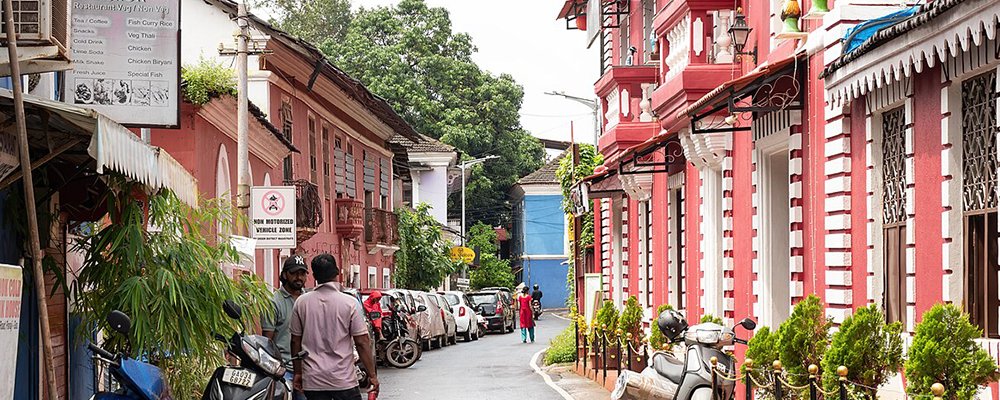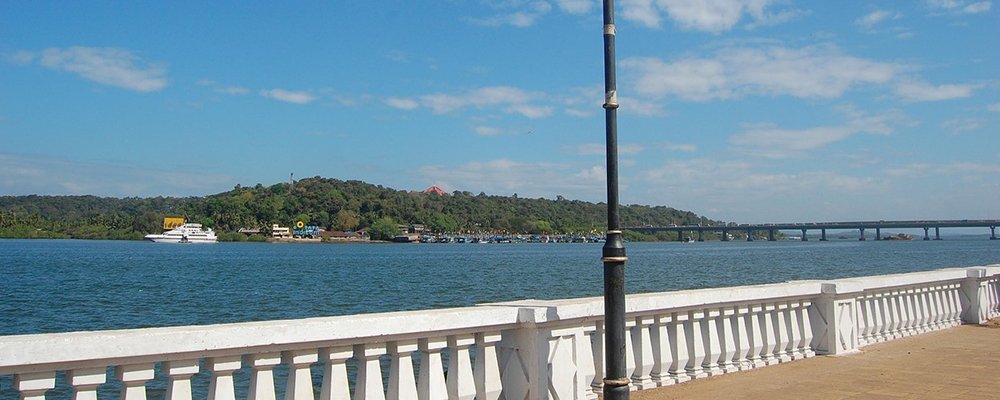For most travellers, Goa is a sunshine paradise state full of beaches, fun, frolics, night-time festivities and a relaxing lifestyle. However, discerning tourists are increasingly turning their attention to what continues to be a secret gem: the state capital, Panaji (Panjim).
Panjim is anything unlike its garish, noisy, full-in-your-face big city cousins of Mumbai and, well, anywhere else in India!
It's difficult to pinpoint Panjim's allure. If you enjoy the old and modern clashing together silently, a lazy river, sightseeing, English-speaking friendly locals, top quality cuisine and art, and even a bit of gambling on the side, Goa's capital is an entrancing visit.
Sitting on the Mandovi River, Panjim has been around for about 1,000 years, with a subtle Portuguese influence for 400 years that still endures even after that officially ended in 1961. It remains an inherent link between the tourist meccas of North and South Goa.
The state opened Manohar International Airport (MOX) in 2022, and it is a 40-minute drive to Panjim. When you get there, the city is easily walkable and clean. In fact, it was recently awarded Cleanest City in India 2025 for cities with populations of up to 200,000 people.
What to See:
Panjim won't disappoint the architecture-crowd, history seekers, the arty or eminently curious.

Fontainhas: The Latin Quarter
For a couple of hours, strike out for the streets of the colourful Fontainhas district, Panjim's 'Latin Quarter'. Recognised as a UNESCO Heritage Zone, the neighbourhood is a living museum of Portuguese architecture with its pastel-hued houses, terracotta roofs, narrow winding lanes, and wrought-iron balconies draped in bougainvillea.
While walking Fontainhas is like stepping back in time, it is also an opportunity to appreciate the brightly-painted homes and the thriving art scene. For art lovers, visit Gitanjali Gallery, Panjim Inn and Fundação Oriente, all of which showcase Goan and contemporary Indian artists in atmospheric heritage settings. Some residents turn their historic homes into art galleries during the annual Fontainhas festival in February.
Head to Velha Goa Galeria for traditional hand-painted azulejos (tin-glazed ceramic tiles), or visit Fonte Phoenix (Fountain of Phoenix), a beautiful natural spring. Don't miss out on Rua de Ourem for its riverside views, or the 19th century St. Sebastian's Chapel.
If all that walking leaves you hungry, then dip into the 100-year-old Goan-Portuguese Bakery Confeitaria at 31 De Janeiro for local delicacies, such as Portuguese custard tarts If your stay demands a more culinary experience, then Viva Panjim is a local legend run by Linda D'Souza, with the restaurant serving up hearty, home-style Goan dishes at reasonable prices. Favourites include prawn curry rice, pork vindaloo, and crab, all infused with aromatic spices and coconut.
Mum's Kitchen is worth the short stroll for its curated menu of Goan recipes sourced from grandmothers across the state, while The Verandah at Panjim Inn offers a refined dining experience steeped in history. Joseph's Bar embodies Goa's laid-back charm with its vintage décor and rustic wooden bar. It's the perfect place for a relaxed evening.
Church of Our Lady of the Immaculate Conception
Heading west from Fontainhas, the imposing 17th-century Church of Our Lady of the Immaculate Conception is a majestic spectacle. Its bright white Baroque exterior with an iconic zigzag staircase that cascades down to the main square is one of the most photographed landmarks in Goa.
Inside, the ornate altar dedicated to the Virgin Mary is striking, while the sweeping views over the city from the church steps are perfect for sunset photos. The feast of the Immaculate Conception in December brings the church to life with lights, music, and festivities.
Museums
A short walk from the Church of Our Lady, situated on the banks of the Mandovi River, is the Goa State Museum. It's an essential visit for understanding the state's dual culture and complex backstory.
Located in the former Secretariat building and near the Adil Shah Palace, the Museum is the city's flagship cultural institution. Established in 1977, it houses an impressive array of 8,000 artefacts spanning centuries of Goan history. Galleries are divided into themes such as sculpture, Christian art, freedom struggle, numismatics, and contemporary art. Visitors can trace Goa's evolution from its early Hindu dynasties to the Portuguese colonial era, and ultimately, to its modern identity.
Nestled within the Convent of Santa Monica in Old Goa, a short drive from central Panjim, the Museum of Christian Art showcases the unique fusion of European and Indian artistry that developed under Portuguese rule. The collection includes gilded altarpieces, silverware, vestments, and paintings, all testaments to Goa's Indo-Portuguese aesthetic.

Overlooking the Mandovi River, the beautifully restored 16th century Reis Magos Fort now serves as a heritage centre and art gallery that celebrates both history and creativity. Visitors can explore exhibits on the fort's past as a defense outpost and later as a prison, alongside contemporary art installations that showcase Goan talent.
Designed by renowned architect Gerard da Cunha, the Houses of Goa Museum in Porvorim is a must-visit. Shaped like a ship, the building is a work of art. Inside, exhibits explore the evolution of Goan domestic architecture, from traditional village homes to grand Indo-Portuguese mansions. Through models, photographs, and sketches, visitors can appreciate how Goan homes reflect centuries of cultural blending and adaptation to tropical life.
For a modern twist, the Goa Science Centre offers an interactive experience for families and young visitors. Its hands-on exhibits, 3D theatre, and planetarium shows make learning about science an engaging and entertaining experience. For the criminally minded, the Goa State Excise Museum focuses on drug trafficking and smuggling.
 Andy Probert is an independent journalist who writes about global travel news, airlines, airports, and business. His work has appeared globally on the BBC, and in many national newspapers and magazines.
Andy Probert is an independent journalist who writes about global travel news, airlines, airports, and business. His work has appeared globally on the BBC, and in many national newspapers and magazines.















